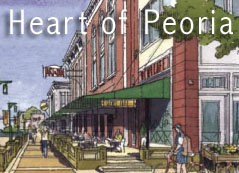 On June 15, four areas of Peoria will be the first to benefit from a new kind of zoning (some might even call it an alternative to zoning): form-based codes. The City Council last night unanimously adopted ordinances that put the new coding into place for the four form districts which are the West Main corridor, Warehouse District, Sheridan/Loucks Triangle, and Prospect Road corridor.
On June 15, four areas of Peoria will be the first to benefit from a new kind of zoning (some might even call it an alternative to zoning): form-based codes. The City Council last night unanimously adopted ordinances that put the new coding into place for the four form districts which are the West Main corridor, Warehouse District, Sheridan/Loucks Triangle, and Prospect Road corridor.
Form-based codes differ from our current zoning (aka “Euclidean zoning) in some significant ways. Whereas Euclidean zoning is primarily concerned about land use and only marginally concerned about design or form, form-based codes are just the opposite. Form-based codes stress limits for height, siting, and building elements, and have only a few limits on uses.
If you want to build a new building along Main street, right now you have to follow the same zoning regulations as if you were building out in a cornfield on the north side of town — setbacks from the street, surface parking requirements, etc. Just take a look at Jimmy John’s on West Main and you’ll get the idea. That’s what infill looks like under suburban zoning code.
Under the form-based codes, infill development will instead be consistent with the current built environment. For instance, on West Main street, any new buildings will have to be built up to the sidewalk and utilize nearby shared parking with other businesses or provide private parking in the rear of the building. Whereas Euclidean zoning separates land uses into residential, commercial, office, etc., form-based codes allow these uses to be mixed, thus making it possible for someone to build an apartment over their store, or to have office space above a retail business.
The council also voted to bring off the table the rest of the Land Development Code (which would apply to the Heart of Peoria Plan area outside of the four form districts) with the Heart of Peoria Commission’s recommendation for the Knoxville corridor, and a recommendation that there be a four-month transitional period following its enactment. This could come before the council as early as next month for adoption.
The transitional period would be a four-month time frame during which projects could still be approved under the old zoning ordinance if the developer can prove that he was relying on those ordinances when making plans, acquiring property, etc. That’s a reasonable request. The council often makes zoning and especially fee changes without any kind of consideration for what that would do to pending projects, so this is really a step forward.

So, are there any projects?